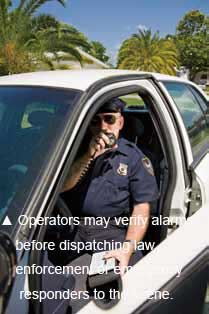INSIGHTS
Alarm monitoring is one of the oldest security businesses. When away from one’s home or business, alarm monitoring offers the reassurance of knowing someone is vigilantly standing by. Should the worst happen — fire, broken window or intrusion — professionals will have taken the appropriate response. The right authorities will be notified by alarm-monitoring operators, providing peace of mind. Global security monitoring revenues totaled about US$40 billion, according to First Research in a July report. This encompasses residential and commercial alarm monitoring. Europe and the U.S. are the largest security system markets, dominated by ADT Security Services, Securitas and G4S. Effective alarm monitoring requires a stable infrastructure, robust enough to not miss a single signal. However, wired or wireless transmission media provide unique benefits and drawbacks. Redundancy depends on multiple technologies. Signal priority makes sense of which alarms are most important. The majority of alarms are false, wasting the time and resources of law enforcement and other first responders. Newer systems have the infrastructure to support audio or video monitoring as secondary verification. However, these systems require more bandwidth or a complete system overhaul, as more customers rely on mobile devices.
Alarm Monitoring Improves Awareness Through More Services
Date: 2011/09/15
Source: a&s International
Real-Life Usage
 Alarm monitoring is expressly designed for worst-case scenarios. Business owners understand that their premises are secured by a remote team, even when no one is in the office.
Alarm monitoring is expressly designed for worst-case scenarios. Business owners understand that their premises are secured by a remote team, even when no one is in the office.
Large alarm centers are best equipped to deal with emergencies, with greater consolidation of smaller dealers or control rooms. When ADT bought Broadview in 2010, it estimated it would take 18 months for integration, including upgrading the central station software platform. “In the case of alarm central stations, the software has been uniquely written to meet specific needs,” Perlin said. “Even two stations operating on the same platform will have enough unique code written into their software to make integration a challenge.”
While it is possible to support legacy systems, they are more difficult to service. “As a system ages, the ability to run remote diagnostics and dial into a panel to fix it is limited,” White said. “We have to dispatch engineers more frequently. It's harder to pull reports, but we still do it.”
On-Site Reporting
Some large commercial users, such as chain stores, may have their own security control room. Alarm monitoring can still play a role in alerting on-site personnel about a situation. “On-site control rooms are unique to specific applications,” Sanchez said. “Even in these scenarios remote central stations can act as a ‘hot' backup. If you are using a remote control room, tasks such as responding to an event with an on-site guard are easily assigned and managed within the central station software. Additionally, any routine or nonroutine follow-up can be accomplished from the remote location as the on-site control room is handling the event.”
Duress alarms can be received off-site, then verified by on-site operators, Yap said.
A retailer with multiple stores may use off-site alarm monitoring to alert security personnel, rather than the shop owner. “If an alarm goes off at night, we will call their security desk,” White said. “They will invoke their own security procedures.”
Building Good Solutions
Selecting hardware and software for alarm stations means the solutions have to run reliably around the clock. “Monitoring stations must use the highest-grade equipment due to the 24/7 nature of their operations,” Perlin said. Consumer-grade TV sets will not be able to deal with heat and power surges that will occur during continuous operation. Professional displays should be bright, have sufficient resolution and accept multiple inputs.
Systems should be modular for smoother integration, rather than one-time customizations that are expensive. “The key thing is people should use industry-standard equipment,” Kelly said. “Most products are not built with the interface because manufacturers want their own advantages and don't think about integration until it's an issue.”
Alarm-monitoring software needs to be configurable and scalable. The software cannot present complexity to the operator. “You have to support product that might be very old,” Kelly said. “It might be used for 20 years — we still have twisted-pair technology we support. But to the operator, it has to be seamless.”